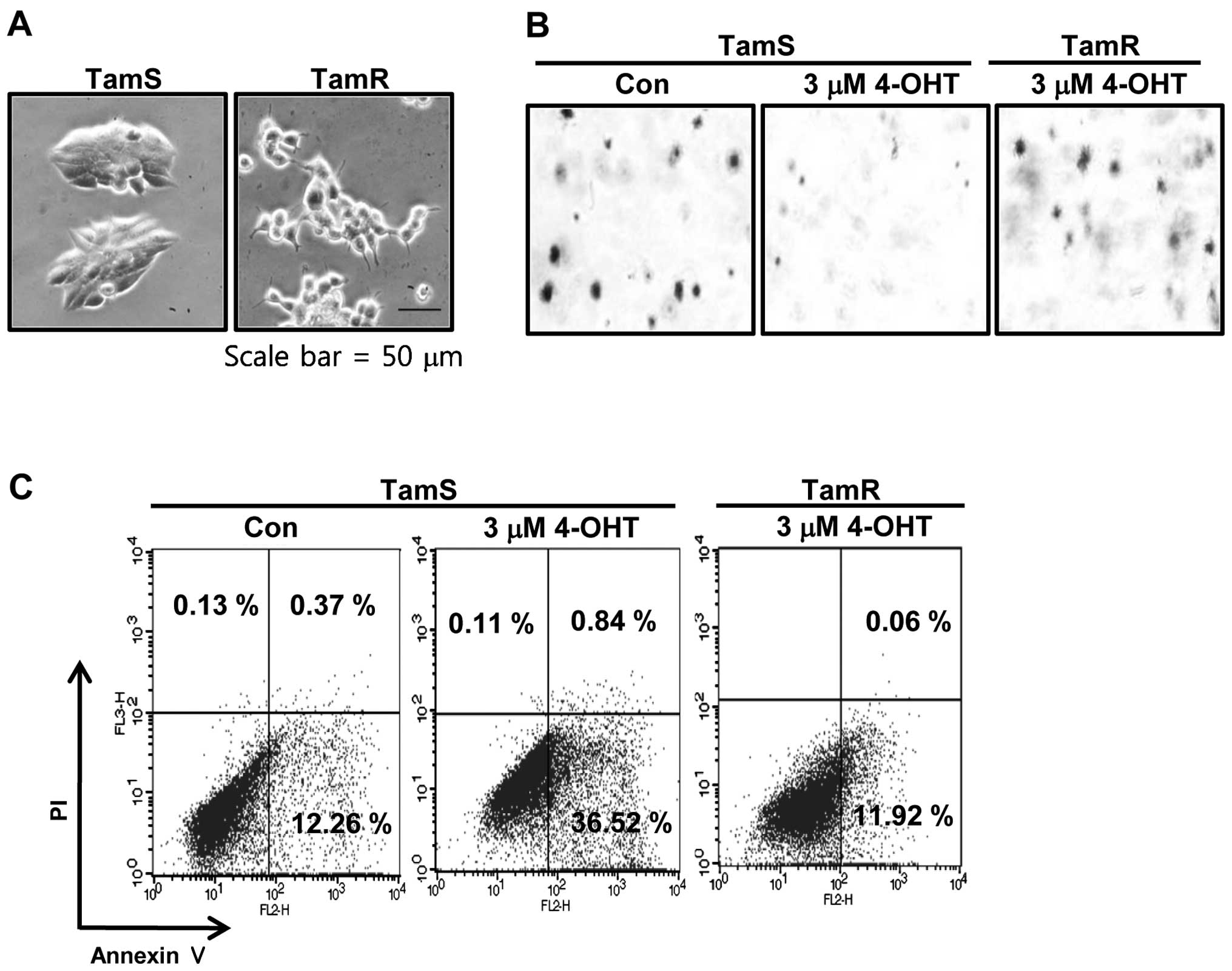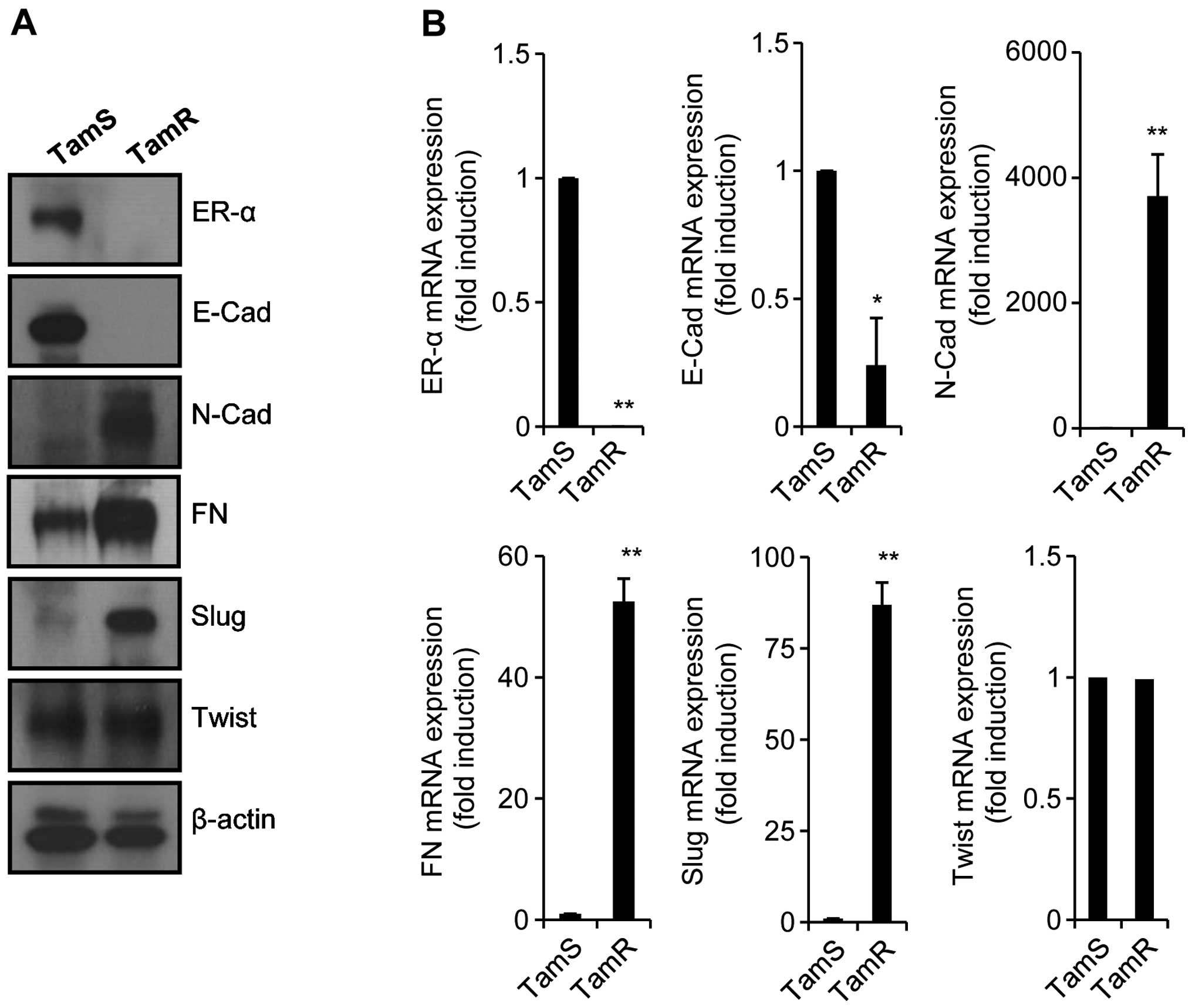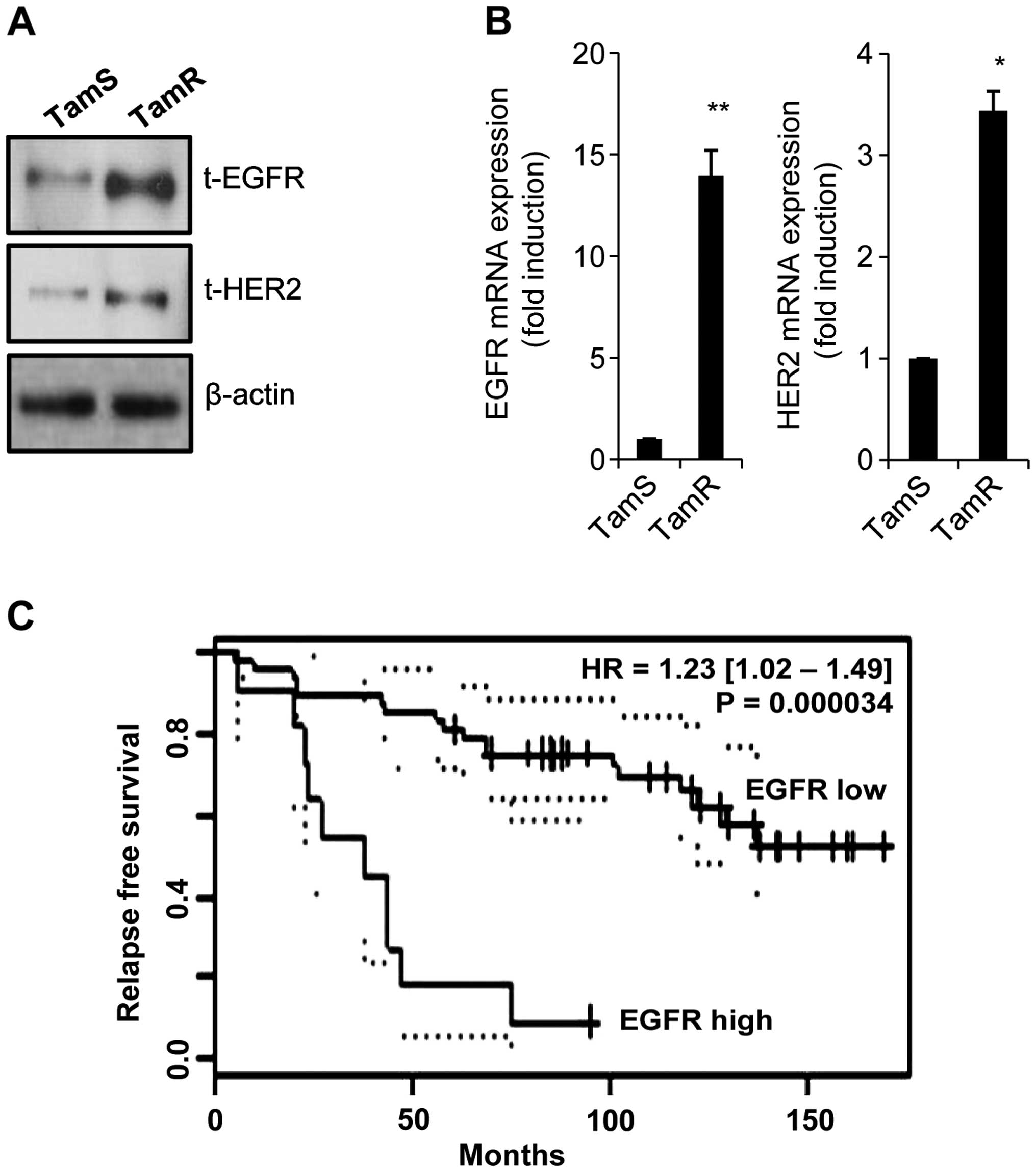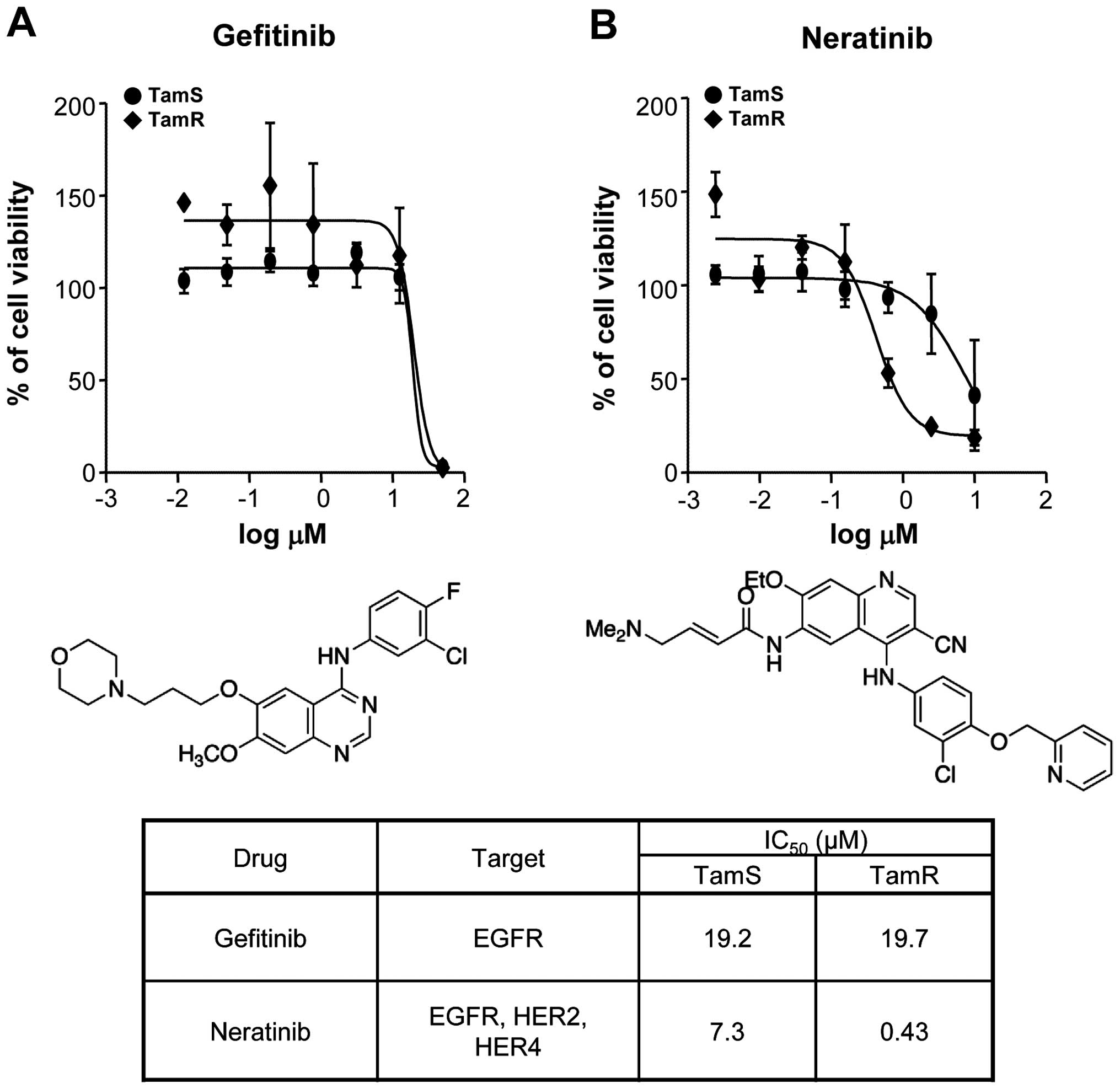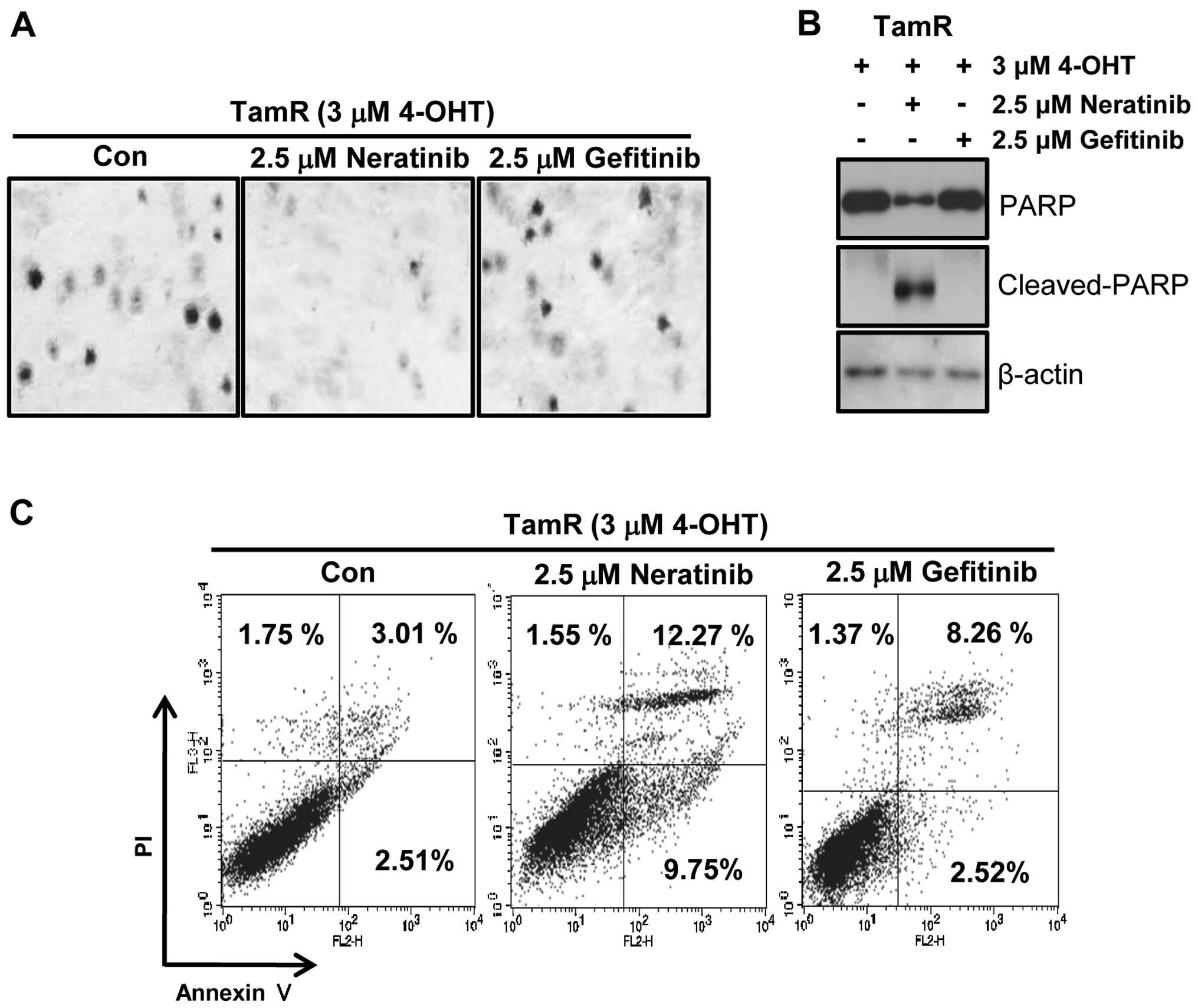Differential effect of EGFR inhibitors on tamoxifen-resistant breast cancer cells
- Authors:
- Published online on: July 8, 2015 https://doi.org/10.3892/or.2015.4116
- Pages: 1613-1619
Abstract
Introduction
Breast cancer is one of the most frequent cancers and the second leading cause of cancer deaths in American women (1). Approximately 70% of breast cancers express estrogen receptors (ER) (1). Εstrogen receptor-α (ER-α) is a very important prognostic marker for selecting an appropriate hormonal therapy (2,3). Breast cancers that express ER and/or the progesterone receptor (PR) are treated with targeted anti-estrogen therapy such as tamoxifen (2,4). Adjuvant tamoxifen therapy is effective to prolong disease-free and overall survival of ER-positive breast cancer patients and induces the arrest of tumor progression in 50% of patients with breast cancer (5). However, although anti-estrogen therapies targeting ER-α prevent disease recurrence in patients with hormone-dependent breast cancer, de novo or acquired resistance occurs during therapy (6,7). Thus, we investigated the effects of new therapeutic drugs for treatment of ER-positive breast cancer patients.
Acquired tamoxifen-resistant (TamR) cells developed from the parental MCF7 breast cancer cells, elevates some epidermal growth factor receptor (EGFR) ligands as well as the level of EGFR and HER2 receptors compared with tamoxifen-responsive MCF7 cells (8). The heterodimerization of enhanced EGFR and HER2 triggers phosphorylation of downstream kinases, including ERK1/2 MAP kinase, Akt, and PKC-α (9–11). In addition, EGF suppresses the expression and activity of the ER-α via the phosphatidylinositol-3-kinase (PI-3K)/Akt pathway in MCF7 cells (12). In contrast, stable transfection of parental MCF-7 cells with a dominant-negative Akt mutant recovers ER-α expression and activity by 70–80% (12). Generally, an inverse correlation between EGFR and ER-α was maintained at relapse on tamoxifen (13). The acquired expression of EGFR during treatment plays an important role in the development of tamoxifen resistance in human breast cancer (14).
In the present study, we evaluated the effect of EGFR inhibitors, neratinib and gefitinib, in tamoxifen-sensitive (TamS) and TamR cells. TamR cells showed mesenchymal phenotypes and highly expressed mesenchymal marker proteins, including fibronectin (FN), N-cadherin (N-cad), and Slug. In addition, the level of EGFR expression was significantly increased in TamR cells. Interestingly, neratinib, one of EGFR inhibitors, induced cell death of TamR but not gefitinib. Therefore, we demonstrated that neratinib treatment may be a promising therapeutic strategy to overcome tamoxifen resistance.
Materials and methods
Reagents
Dulbecco's modified Eagle's medium (DMEM) was purchased from Thermo Scientific (Hemel Hempstead, UK). Fetal bovine serum (FBS) was purchased from Hyclone (Logan, UT, USA). Phenol red-free DMEM, penicillin (100 U/ml) and 100 mg/ml streptomycin were purchased from Life Technologies (Rockville, MD, USA). Neratinib and gefitinib were purchased from Selleck Chemicals (Houston, TX, USA). 4-Hydroxytamoxifen (4-OHT) was purchased from Sigma-Aldrich (St. Louis, MO, USA). Rabbit monoclonal anti-PARP-1, FN, ER-α, and Twist were purchased from Epitomics (Burlingame, CA, USA). Epithelial-mesenchymal transition (EMT) antibody sampler [E-cadherin (E-cad), N-cad, and Slug antibodies] was purchased from Cell Signaling Technology (Beverly, MA, USA). The secondary HRP-conjugated antibody and mouse monoclonal anti-β-actin antibody were purchased from Santa Cruz Biotechnology, Inc. (Santa Cruz, CA, USA). The ECLprime reagents were purchased from Amersham (Buckinghamshire, UK).
Establishment of TamR MCF7 breast cancer cells
TamS and TamR breast cancer cell lines were kindly provided by Professor Keun Wook Kang (Seoul National University, Seoul, Korea). The TamR was established using methodology reported previously (8). Briefly, to establish TamR, MCF-7 cells were washed with PBS, and the culture medium was changed to phenol red-free DMEM containing 10% charcoal-stripped steroid-depleted FBS (both from Life Technologies) and 0.1 mM 4-OHT. The cells were continuously exposed to this treatment regimen for 2 weeks, and the 4-OHT concentration was increased gradually up to 3 mM over a 9-month period. Initially, cell growth rates were depressed. However, after exposure to the medium for 9 months, the rate of cell growth increased gradually, indicating the establishment of TamR cells.
Soft agar colony formation assay
TamS and TamR cells were seeded at a density of 5×104 cells/well in 6-well plates in growth medium containing 0.7% agar (1.5 ml/well) on top of a layer of growth medium containing 1.4% agar (2 ml/well). Growth medium (500 μl) with 10% FBS was added on top of the agar. The cell suspension was plated and cultured in a 37°C incubator for 2 weeks. After 2 weeks, viable colonies were stained 0.01% crystal violet and then were observed using a CK40 inverted microscope (Olympus, Tokyo, Japan).
Flow cytometry analysis (FACS)
Apoptosis assays were performed with the Annexin V-fluorescein isothiocyanate (FITC) apoptosis kit-I (BD Pharmingen, San Diego, CA, USA), according to the manufacturers instructions. Briefly, cells (1×106 cells/ml) were collected and washed twice with PBS and then resuspended in 500 μl of staining solution containing 5 μl FITC-conjugated Annexin V and propidium iodide (PI). After incubation for 15 min at room temperature (RT) in the dark, cells were immediately analyzed on a flow cytometer. Apoptotic cells were double-stained with Annexin V and PI and then they were analyzed using the FACS Vantage system (Becton-Dickinson, San Diego, CA, USA). The percentage of cells undergoing apoptosis was determined.
Cell viability
To measure the sensitivities to EGFR inhibitors, neratinib or gefitinib, we analyzed using a Countess Automated Cell Counter (Invitrogen, Carlsbad, CA, USA). Briefly, TamS and TamR cells (5×104 cells/well) were seeded onto 6-well plates. TamS and TamR cells were incubated in phenol red-free DMEM containing 10% charcoal-stripped steroid-depleted FBS without 3 μM 4-OHT and 2.5 μM neratinib or gefitinib, respectively for 24 h.
Western blotting
The cell lysates were used in the immunoblot analysis for PARP-1, E-cad, N-cad, FN, Twist, Slug, EGFR, HER2, and β-actin. The proteins were boiled for 5 min in Laemmli sample buffer and then electrophoresed on 8% or 10% sodium dodecyl sulfate-polyacrylamide gel electrophoresis gels. The proteins were transferred to PVDF membranes, and the membranes were blocked with 10% skim milk in TBS with 0.01% Tween-20 for 15 min. The blots were incubated with anti-PARP-1, ER-α, E-cad, N-cad, FN, Twist, Slug, EGFR, HER2, and β-actin antibodies (1:1,000 dilution) in 1% TBS/T buffer (0.01% Tween-20 in TBS) at 4°C overnight. The blots were washed 3 times in TBS with 0.01% Tween-20, and they were subsequently incubated with anti-rabbit HRP-conjugated antibody (1:5,000 dilution) in TBS/T buffer. After 1-h incubation at RT, the blots were washed 3 times and ECLprime reagents were applied for further development.
Microarray data analysis
We downloaded expression data from a public database (GSE1378) and analyzed the clinical value of EGFR in tamoxifen-treated breast cancer patients.
Real-time polymerase chain reaction (RT-PCR)
Total RNA was extracted from the cells using TRIzol reagent (Invitrogen), according to the manufacturers instructions. Isolated RNA samples were then used for RT-PCR. Samples (1 μg total RNA) were reverse-transcribed into cDNA in 20-μl reaction volumes using a First Strand cDNA synthesis kit for RT-PCR, according to the manufacturer's instructions (MBI Fermentas, Hanover, MD, USA).
Gene expression was quantified by real-time PCR using a SensiMix SYBR kit (Bioline Ltd., London, UK) and 100 ng of cDNA per reaction. The sequences of the primer sets used for this analysis are shown in Table I. An annealing temperature of 60°C was used for all primers. PCRs were performed in a standard 384-well plate format with an ABI 7900HT Real-Time PCR detection system (Applied Biosystems, Foster City, CA, USA). The raw threshold cycle (CT) value was first normalized to the housekeeping gene for each sample to obtain ΔCT. The normalized ΔCT was then calibrated to the control cell samples to obtain ΔΔCT. All cDNA samples were analyzed in 3 independent experiments.
Statistical analysis
Statistical significance was determined using the Student's t-test. Results are presented as means ± standard errors. All P-values are two-tailed, and differences were considered significant at P<0.05.
Results and Discussion
To establish a new therapeutic strategy for treatment of TamR breast cancer, we analyzed differential characteristics of TamS and TamR breast cancer cell lines. In a previous study, breast cancer cell lines could be classified into four distinct morphological groups referred to as round, mass, grape-like, and stellate (15). As shown in Fig. 1A, we also observed the morphological difference between TamS and TamR cells. TamS cells stacked up to form colonies and TamR cells scattered, in loosely-packed colonies, and had many branches. In addition, to assess the tumorigenicity degree of TamS and TamR cells, we examined the effect of tamoxifen on the ability of cells to form colonies using soft agar colony formation assays. The colonies of TamS cells were greatly decreased by 3 μM tamoxifen treatment while TamR cells still maintained colonies (Fig. 1B). We also measured the apoptotic cell death of TamS and TamR cells by tamoxifen. Cells were treated with 3 μM tamoxifen for 24 h and examined by Annexin V/PI staining. As shown in Fig. 1C, the apoptotic cell population of TamS cells was significantly increased by 3-fold of control level. However, the apoptotic cell population of TamR cells was similar to control of TamS (Fig. 1C).
In a previous study, tamoxifen resistance was associated with enhanced cell motility (16). Antiestrogens also promote cellular invasion and motility in TamR breast cancer cells (17). In addition, TamR MCF7 cells promote EMT-like behavior and inhibition of EGFR in these cells augments cell-cell adhesion (18). Thus, we also investigated the relationship between the morphological change of TamR cells and EMT. Although the level of Twist expression did not change, the expression levels of mesenchymal marker proteins such as N-cad, FN, and Slug, was significantly increased in TamR cells (Fig. 2A). In contrast, ER-α and E-cad expression (epithelial marker protein) was decreased in TamR cells (Fig. 2A). Our results also showed that the mRNA expression of these proteins was similar with the patterns of proteins expression (Fig. 2B). Therefore, we demonstrated that tamoxifen resistance is associated with the severe reduction of ER-α expression and the induction of EMT.
We observed that the levels of EGFR and HER2 proteins and mRNA expression were dramatically enhanced in TamR cells (Fig. 3A and B). The levels of EGFR and HER2 mRNA expression were increased by 14.0-fold and 3.4-fold of control level, respectively (Fig. 3A and B). Consistent with our data, the induction of growth factor receptors, such as EGFR and HER2 has been implicated in acquired resistance to endocrine therapy (19,20). Snail overexpressed cells are resistant to tamoxifen and increase the level of EGFR expression (21). Next, we analysed the clinical value of EGFR expression in tamoxifen-treated breast cancer patients using public microarray datasets (GSE1378). Interestingly, patients with high EGFR expression levels showed significantly shorter relapse-free survival time (Fig. 3C, P=0.000034). These results suggest that the level of EGFR expression plays an important role in tamoxifen resistance.
We investigated the effect of EGFR inhibitors, neratinib and gefitinib, in TamS and TamR cells. Neratinib (HKI-272, Pfizer; Puma Biotechnology) is a pan-HER receptor tyrosine kinase inhibitor (EGFR, HER2 and HER4) and binds irreversible to these kinases (22). Gefitinib (Iressa; AstraZeneca Pharmaceuticals) is the first selective inhibitor of EGFR tyrosine kinase domain and is responsible for activating anti-apoptotic pathways in non-small cell lung cancers (23). As shown in Fig. 4A, gefitinib did not affect the viabilities of TamS and TamR cells. The IC50 value of gefitinib was ~20 μM concentration. However, neratinib significantly decreased the viability of TamR cells at 0.43 μM concentration but the viability of TamS cells did not change by 7.3 μM neratinib treatment (Fig. 4B). Therefore, we demonstrated that neratinib prevents more effectively EGFR and HER2 signaling pathways as well as triggers apoptotic cell death of TamR cells.
To evaluate the tumorigenicity of TamR cells by EGFR inhibitors, we examined the effect of neratinib and gefitinib on the ability of cells to form colonies using soft agar colony formation assays. As shown in Fig. 5A, the colonies of TamR cells were completely decreased by 2.5 μM neratinib treatment while gefitinib-treated TamR cells still maintained colonies. Furthermore, one of apoptosis marker proteins, cleaved PARP-1 expression was also dramatically increased by neratinib treatment (Fig. 5B). Finally, we also measured the apoptotic cell death of TamR cells by neratinib and gefitinib. Cells were treated with 2.5 μM neratinib and gefitinib, respectively for 24 h. The apoptotic cell population of TamR cells by neratinib was significantly increased by 4-fold of control level (Fig. 5C). However, the apoptotic cell population by gefitinib was slightly increased (Fig. 5C). Therefore, we suggest that neratinib may be a new therapeutic drug for treatment of TamR breast cancer.
Acknowledgments
This research was supported by a grant of the Korea Health Technology R&D Project through the Korea Health Industry Development Institute (KHIDI), funded by the Ministry of Health and Welfare, Republic of Korea (HI14C3418) and by the Samsung Biomedical Research Institute grant (SMX1131701).
References
|
Jemal A, Siegel R, Xu J and Ward E: Cancer statistics, 2010. CA Cancer J Clin. 60:277–300. 2010. View Article : Google Scholar : PubMed/NCBI | |
|
Osborne CK, Zhao H and Fuqua SA: Selective estrogen receptor modulators: structure, function, and clinical use. J Clin Oncol. 18:3172–3186. 2000.PubMed/NCBI | |
|
Harvey JM, Clark GM, Osborne CK and Allred DC: Estrogen receptor status by immunohistochemistry is superior to the ligand-binding assay for predicting response to adjuvant endocrine therapy in breast cancer. J Clin Oncol. 17:1474–1481. 1999.PubMed/NCBI | |
|
Herynk MH and Fuqua SA: Estrogen receptors in resistance to hormone therapy. Adv Exp Med Biol. 608:130–143. 2007. View Article : Google Scholar : PubMed/NCBI | |
|
Ali S and Coombes RC: Endocrine-responsive breast cancer and strategies for combating resistance. Nat Rev Cancer. 2:101–112. 2002. View Article : Google Scholar | |
|
Kurebayashi J: Endocrine-resistant breast cancer: underlying mechanisms and strategies for overcoming resistance. Breast Cancer. 10:112–119. 2003. View Article : Google Scholar : PubMed/NCBI | |
|
Schiff R, Massarweh S, Shou J and Osborne CK: Breast cancer endocrine resistance: how growth factor signaling and estrogen receptor coregulators modulate response. Clin Cancer Res. 9:447S–454S. 2003.PubMed/NCBI | |
|
Knowlden JM, Hutcheson IR, Jones HE, Madden T, Gee JM, Harper ME, Barrow D, Wakeling AE and Nicholson RI: Elevated levels of epidermal growth factor receptor/c-erbB2 heterodimers mediate an autocrine growth regulatory pathway in tamoxifen-resistant MCF-7 cells. Endocrinology. 144:1032–1044. 2003. View Article : Google Scholar : PubMed/NCBI | |
|
Kim S, Lee J, Lee SK, Bae SY, Kim J, Kim M, Kil WH, Kim SW, Lee JE and Nam SJ: Protein kinase C-α downregulates estrogen receptor-α by suppressing c-Jun phosphorylation in estrogen receptor-positive breast cancer cells. Oncol Rep. 31:1423–1428. 2014. | |
|
Benz CC, Scott GK, Sarup JC, Johnson RM, Tripathy D, Coronado E, Shepard HM and Osborne CK: Estrogen-dependent, tamoxifen-resistant tumorigenic growth of MCF-7 cells transfected with HER2/neu. Breast Cancer Res Treat. 24:85–95. 1992. View Article : Google Scholar | |
|
Li Z, Wang N, Fang J, Huang J, Tian F, Li C and Xie F: Role of PKC-ERK signaling in tamoxifen-induced apoptosis and tamoxifen resistance in human breast cancer cells. Oncol Rep. 27:1879–1886. 2012.PubMed/NCBI | |
|
Martin MB, Franke TF, Stoica GE, Chambon P, Katzenellenbogen BS, Stoica BA, McLemore MS, Olivo SE and Stoica A: A role for Akt in mediating the estrogenic functions of epidermal growth factor and insulin-like growth factor I. Endocrinology. 141:4503–4511. 2000.PubMed/NCBI | |
|
deFazio A, Chiew YE, McEvoy M, Watts CK and Sutherland RL: Antisense estrogen receptor RNA expression increases epidermal growth factor receptor gene expression in breast cancer cells. Cell Growth Differ. 8:903–911. 1997.PubMed/NCBI | |
|
Newby JC, Johnston SR, Smith IE and Dowsett M: Expression of epidermal growth factor receptor and c-erbB2 during the development of tamoxifen resistance in human breast cancer. Clin Cancer Res. 3:1643–1651. 1997. | |
|
Kenny PA, Lee GY, Myers CA, Neve RM, Semeiks JR, Spellman PT, Lorenz K, Lee EH, Barcellos-Hoff MH, Petersen OW, et al: The morphologies of breast cancer cell lines in three-dimensional assays correlate with their profiles of gene expression. Mol Oncol. 1:84–96. 2007. View Article : Google Scholar | |
|
Zhou C, Zhong Q, Rhodes LV, Townley I, Bratton MR, Zhang Q, Martin EC, Elliott S, Collins-Burow BM, Burow ME, et al: Proteomic analysis of acquired tamoxifen resistance in MCF-7 cells reveals expression signatures associated with enhanced migration. Breast Cancer Res. 14:R452012. View Article : Google Scholar : PubMed/NCBI | |
|
Borley AC, Hiscox S, Gee J, Smith C, Shaw V, Barrett-Lee P and Nicholson RI: Anti-oestrogens but not oestrogen deprivation promote cellular invasion in intercellular adhesion-deficient breast cancer cells. Breast Cancer Res. 10:R1032008. View Article : Google Scholar : PubMed/NCBI | |
|
Hiscox S, Jiang WG, Obermeier K, Taylor K, Morgan L, Burmi R, Barrow D and Nicholson RI: Tamoxifen resistance in MCF7 cells promotes EMT-like behaviour and involves modulation of beta-catenin phosphorylation. Int J Cancer. 118:290–301. 2006. View Article : Google Scholar | |
|
Hutcheson IR, Knowlden JM, Madden TA, Barrow D, Gee JM, Wakeling AE and Nicholson RI: Oestrogen receptor-mediated modulation of the EGFR/MAPK pathway in tamoxifen-resistant MCF-7 cells. Breast Cancer Res Treat. 81:81–93. 2003. View Article : Google Scholar : PubMed/NCBI | |
|
Kurokawa H, Lenferink AE, Simpson JF, Pisacane PI, Sliwkowski MX, Forbes JT and Arteaga CL: Inhibition of HER2/neu (erbB-2) and mitogen-activated protein kinases enhances tamoxifen action against HER2-overexpressing, tamoxifen-resistant breast cancer cells. Cancer Res. 60:5887–5894. 2000.PubMed/NCBI | |
|
Jiang Y, Zhao X, Xiao Q, Liu Q, Ding K, Yu F, Zhang R, Zhu T and Ge G: Snail and Slug mediate tamoxifen resistance in breast cancer cells through activation of EGFR-ERK independent of epithelial-mesenchymal transition. J Mol Cell Biol. 6:352–354. 2014. View Article : Google Scholar : PubMed/NCBI | |
|
Rabindran SK, Discafani CM, Rosfjord EC, Baxter M, Floyd MB, Golas J, Hallett WA, Johnson BD, Nilakantan R, Overbeek E, et al: Antitumor activity of HKI-272, an orally active, irreversible inhibitor of the HER-2 tyrosine kinase. Cancer Res. 64:3958–3965. 2004. View Article : Google Scholar : PubMed/NCBI | |
|
Sordella R, Bell DW, Haber DA and Settleman J: Gefitinib-sensitizing EGFR mutations in lung cancer activate anti-apoptotic pathways. Science. 305:1163–1167. 2004. View Article : Google Scholar : PubMed/NCBI |



